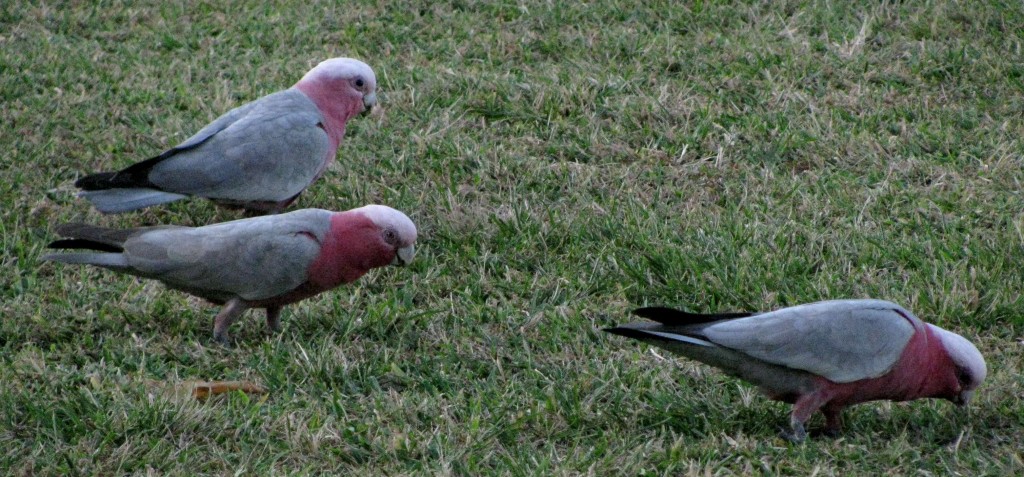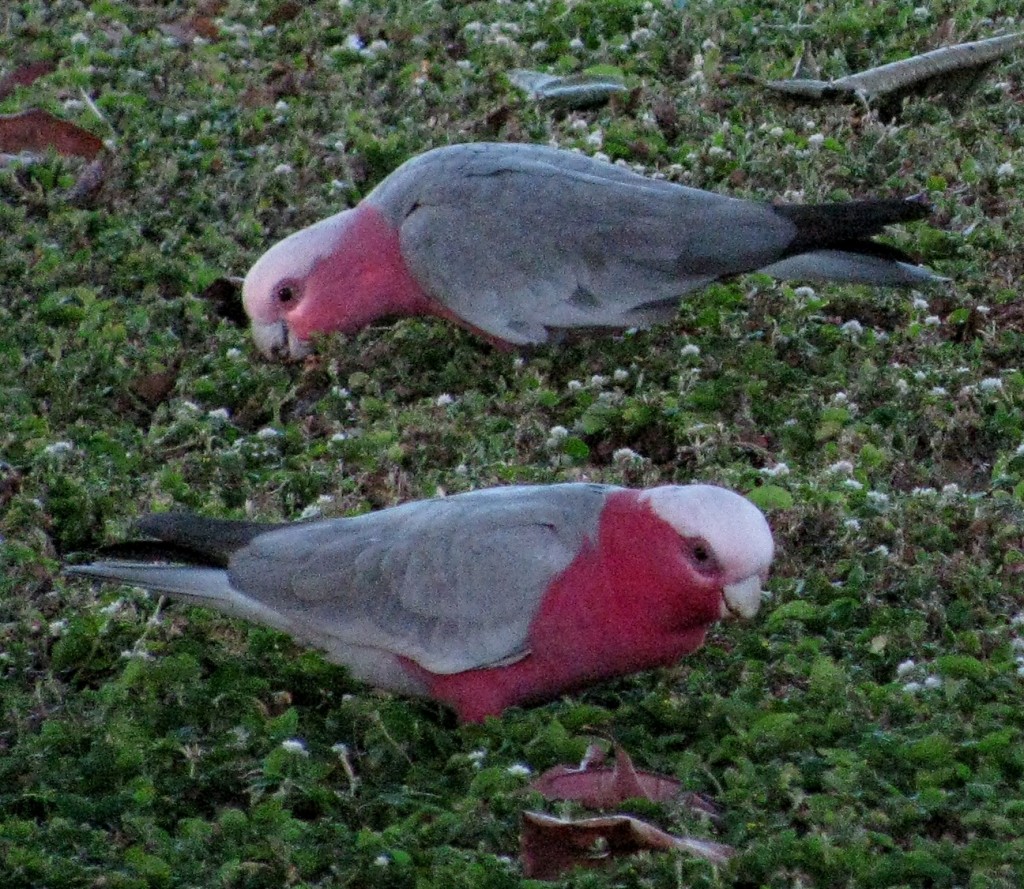
Galahs (© Magi Nams)
Warm wind caressed my bare legs as I walked past the golf course, the sun’s rays still at burning intensity even though dusk would fall within an hour. The practice lawn was littered with golf balls blasted to their present positions by a golfer practising drives. A magpie-lark and masked lapwing stood among the balls, as though curious about those odd white orbs, and unknowing or uncaring of the fact that they were directly in the line of fire of the golfer. A faint half-moon rode high in blue sky, and green seed pods of shade trees hung like curtains of string beans, windchimes of unripe sausages, or flat, puckered fringes wherein every seed was a yellow, eye-like smear.

Galahs Foraging on Golf Course (© Magi Nams)
For the first time, I saw galahs feeding on the golf course, the cockatoos attired in grey, pink, and white plumages and foraging as a group of five and a pair. Whereas rainbow lorikeets are eye-catchingly vivid, and both sulphur-crested cockatoos and red-tailed black-cockatoos are strikingly dramatic in their colouring, the galahs’ beauty was more an understated elegance. The birds plucked grasses with their thick, pale grey beaks, and waddled away from me when I approached with my camera. Galahs are an Australian bird species that has benefitted from the settlement of the continent by Europeans, who cleared forests to create grazing lands and, thus, increased the galahs’ food supplies.1
Let me relate an Aboriginal story which tells how Galah received her white head.2 One day, Oolah the lizard was showing off his prowess with his boomerangs, one of which struck Galah on top her head as it was returning to Oolah. The returning boomerang, called a bubberah, cut off the feathers and skin from the bird’s crown, causing her to bleed copiously and shriek with pain. When the lizard, frightened because of what had happened, tried to escape beneath a prickly bindeah bush, the injured and angry Galah dragged him out and rolled him over the bush until his skin was impaled with bindeah spines. She rubbed her bleeding head over him, colouring him red. This, the legend tells us, is why Galah is ever shrieking her hideous shriek and has a bald head, and why lizards living in Galah’s land are reddish brown and covered with spikes.
The galahs I observed on the golf course emitted no hideous shrieks; rather, I heard high-pitched, whistle-like calls as they lifted into the air, the grey of their long wings contrasting with pink wing linings. And not all galahs have white crowns and crests. Two races occur, with a pink-crowned and -crested race found only in Western Australia.1 Throughout the country, galahs have a reputation for foolishness, with Aussie slang referring to silly or foolhardy people as ‘galahs.’ This is supposedly related to the foolish antics and noises produced by real galahs,3 neither of which I’ve seen or heard. Perhaps those pink-crested galahs are the foolish ones, and perhpas I’ll observe them in Western Australia. We leave on Thursday.
References:
1. Graham Pizzy and Frank Knight. 1997. The Field Guide to Birds of Australia. Angus & Robertson, Sydney. p. 262.
2. K. Langloh Parker. The Galah and Oolah the Lizard. Australian Legendary Tales Folk-Lore of the Noongahburrahs as Told to the Piccaninnies, 1895. Australian Genealogy: Genealogy Down Under. Accessed 25-May-2010. http://www.australiangenealogy.org/australian_legendary_tales.htm
3. Koala Net Lives in Australia. Australian Slang. 1997-2010. Updated 22-Apr-2010. Accessed 25-May-2010. http://www.koalanet.com.au/australian-slang.html


